If you are interested in attracting butterflies to your yard, then you aren’t alone. Many people dream of having lots of beautiful butterflies flitting across their property. To accomplish your dream of attracting butterflies, you may be thinking about planting a butterfly garden or you may have already planted one.
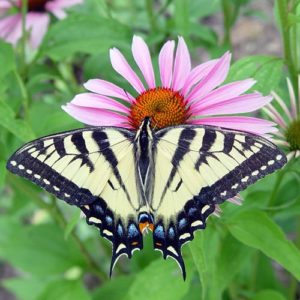
Butterfly gardens are extremely popular and only continue to grow in popularity. When done properly, they can be a great way to attract butterflies to your yard. They can even be the first step in transforming your yard into a miniature ecosystem that supports not only butterflies, but also songbirds and other wildlife. However, to attract the most butterflies to your property, you need to go beyond just planting pretty flowers.
Here are five tips to help you achieve your goal of attracting butterflies to your property. Depending on your property and situation, you may not be able to do all of them. That’s ok. If you have a small property, look around you. See what’s lacking in your area and try to fill in the gaps. The important thing is to be aware and to do what you can.
1) Have lots of flowers blooming throughout the growing season.
While attracting the most butterflies to your property means going beyond just planting pretty flowers, this is still an important first step. Many adult butterflies will visit and drink nectar from a wide range of flowers. So having lots of flowers blooming throughout the growing season, gives them lots of options and plenty of food throughout the spring, summer, and fall.
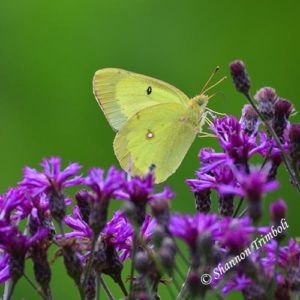
But not all flowers are created equal when it comes to attracting butterflies. Butterflies tend to prefer flowers that have nice, flat, landing platforms that they can easily walk around on as they sip nectar. To get an idea of what I mean by a landing platform, think about the size and shape of sunflowers, coneflowers, goldenrods, milkweeds, and other flowers that you frequently see butterflies visiting.
Yes, there are exceptions and the size of the butterfly influences the size of the landing platform it needs. But as a general guideline, flowers that provide landing platforms are going to be more attractive than tubular flowers or others shapes which don’t give the butterfly an easy place to land while feeding.
2) Plant and grow as many different types of plants that are native to your area as possible.
When we think about attracting butterflies to our properties, we’re often thinking about the adult butterflies. However, it’s really hard to have adults if you don’t have any babies first. That’s true of anything. So it’s just as important to meet the needs of the caterpillars (baby butterflies) as it is to meet the needs of the adults.
While the adult butterflies will often drink nectar from a wide variety of flowers, their babies are often picky eaters. How picky the caterpillars are depends on the species. Some species can eat the foliage from multiple different families of plants. Others may only be able to eat the foliage from plants in a single family or maybe even a single genus.
So, in the interest of providing caterpillar baby food, you need to grow as many different types of native plants as possible. Choosing plants that are native to your region is important because the caterpillars may not be able to digest plants from other parts of the world.
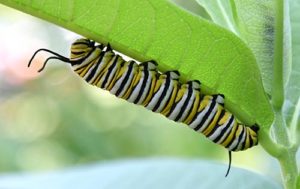
The reason caterpillars often can’t digest plants from other areas is because different species of plants have different chemical compositions. Those chemical compositions have evolved over eons to keep things from eating them.
Caterpillars that have evolved with those plants are more likely to have developed ways to overcome the plant’s chemical defenses. Those that haven’t, aren’t as likely to be able to. (Not every caterpillar can overcome every plant’s defenses either, which is why caterpillars are often picky eaters.)
The term used to describe a species of plant that is eaten by caterpillars is a host plant. Host plant is a relative term that applies to a single species of caterpillar. A plant may be a host plant for multiple species of caterpillars, but nothing is a host plant for ALL caterpillars. That’s why having a wide variety of native plants will attract more butterflies. The variety makes it more likely that you’ll have host plants for more caterpillar species.
It’s also important to note that not all host plants have pretty flowers at ground level. Some host plants are trees. Others are grasses. Some may be herbaceous plants, but have tiny, nondescript flowers that we tend not to notice and would probably never consider growing for their own sake.
If you know there are specific butterfly species that you want to attract, make sure you include the host plants for their caterpillars. Monarchs and milkweeds are probably the most famous example. A few other examples for popular butterflies are spicebush for spicebush swallowtails, violets for great spangled fritillaries, papaws for zebra swallowtails, and legumes for sulphur butterflies.
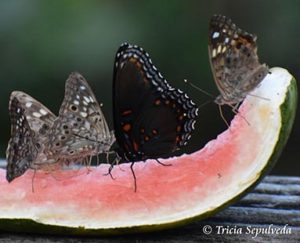
3) Think about other potential ways to attract butterflies, especially the species that typically don’t visit flowers.
Some butterflies behave in very “unbutterfly-like” ways. They rarely if ever drink nectar so rarely if ever visit our garden flowers. These butterflies may drink sap from tree wounds or suck nutrients from overripe fruit, scat (poop), or rotting critters. While putting scat or roadkill in your butterfly garden is generally frowned upon, and for good reason, there are other things you can do to attract some of these species to your yard.
One way is to put watermelon rinds or overripe fruit out for them. This recommendation comes with two cautions.
- Make sure you only put a little out at a time.
- Make sure you bring in or dispose of any fruit or rinds every night.
Failure to follow these two cautions risks creating a nuisance situation with racoons, opossums, bears, or other critters. Red spotted purples and hackberry emperor butterflies are two species that rarely come to flowers but will often come to fruit offerings in the summer.
Another recommendation is to create mudding or puddling spots. Mudding or puddling spots are simply wet areas where the butterflies can land to suck moisture and nutrients out of the ground. Wet soil can create great mudding spots, but so can rocky areas. Wet spots along our gravel driveway are favorite mudding spots for our butterflies. I’m sure they are getting nutrients that have leached out of the limestone gravel.
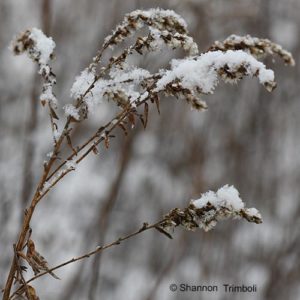
4) Provide year-round habitat because most butterflies don’t fly away for the winter.
Monarchs and a dozen or so other species of butterflies migrate south in the fall and then return in the spring. For those species, year-round habitat isn’t necessary because they aren’t here all year long. However, most species don’t do that. That means we need to take care of their needs all year long, not just in the summer with pretty flowers.
Most of our butterflies spend the winter as a caterpillar, chrysalis, or an egg either attached to standing vegetation or buried in fallen leaves and other vegetation. A few species spend the winter as adults crammed into tree cracks, under loose bark, or buried in fallen leaves and other vegetation.
Some great ways to provide year-round habitat for our butterflies is to leave standing dead vegetation in place. If it is falling into the walkway or doesn’t meet your aesthetic preferences, you can also gently move the vegetation somewhere that it isn’t in the way or isn’t as visible. The same thing is true for fall leaves.
One thing that I would caution against is putting up a butterfly box. These are long, skinny, rectangular, wooden boxes with slits in one or more sides. They are promoted as roosting sites for butterflies, especially during the winter. However, there are no records of butterflies actually using these boxes. Instead, they are more likely to shelter caterpillar predators, like the non-native European paper wasp.
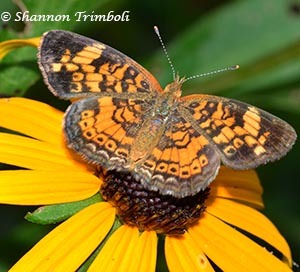
5) Reduce your use of pesticides.
It should go without saying, but I’ll say it anyway. Reduce or eliminate your use pesticides in and around your butterfly garden. Pesticides include insecticides, herbicides, and fungicides. Even organic and “natural, homemade remedies” can be harmful to butterflies and their caterpillars.
Remember, caterpillars have to eat in order to turn into the butterflies we all love. Our native plants are adapted to being eaten by our native caterpillars and bounce back rapidly. Every year I watch the young purple coneflowers in our nursery get completely defoliated by pearl crescent caterpillars. In less than a month, the plant has produced new foliage and you can’t even tell that the caterpillars were on the plants. Having lots of species blooming and growing in your garden also distracts your eye and camouflages the plants that have been munched on.
We have lots of exciting opportunities planned with Backyard Ecology over the next several months. If you want to keep up with everything going on in the Backyard Ecology world, then please subscribe to our emails. When you sign up for our emails, you’ll be sent a link to download a free, e-book that explains why our familiar garden zones, aren’t important when it comes to gardening with native plants. That’s just our way of saying thank you for your interest in Backyard Ecology.

Backyard Ecology: Exploring Nature in Your Backyard
Nature isn’t just “out there.” It’s all around us, including right outside our doors. Hi, my name is Shannon Trimboli, and I am the host of Backyard Ecology. I live in southcentral Kentucky and am a wildlife biologist, educator, author, beekeeper, and owner of a nursery specializing in plants for pollinators and wildlife conservation. I invite you to join me as we ignite our curiosity and natural wonder, explore our yards and communities, and improve our local pollinator and wildlife habitat. Learn more or subscribe to my email list at www.backyardecology.net.

Leave a Reply